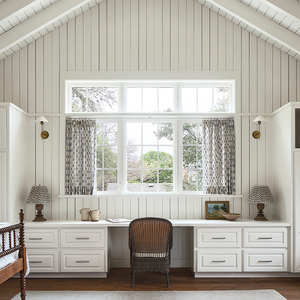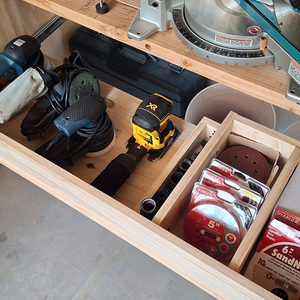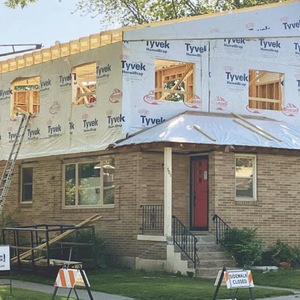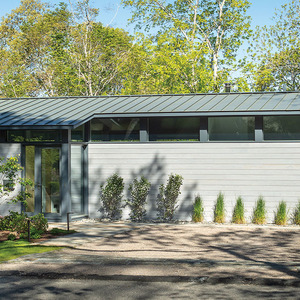I need to replace my trellis in my backyard because one of the posts is rotting. My question is, should I replace it with wood or should I get an aluminum trellis that may withstand the elements better?
Discussion Forum
Discussion Forum
Up Next
Video Shorts
Featured Story

Join some of the most experienced and recognized building professionals for two days of presentations, panel discussions, networking, and more.
Featured Video
How to Install Exterior Window TrimHighlights
"I have learned so much thanks to the searchable articles on the FHB website. I can confidently say that I expect to be a life-long subscriber." - M.K.
Fine Homebuilding Magazine
- Home Group
- Antique Trader
- Arts & Crafts Homes
- Bank Note Reporter
- Cabin Life
- Cuisine at Home
- Fine Gardening
- Fine Woodworking
- Green Building Advisor
- Garden Gate
- Horticulture
- Keep Craft Alive
- Log Home Living
- Military Trader/Vehicles
- Numismatic News
- Numismaster
- Old Cars Weekly
- Old House Journal
- Period Homes
- Popular Woodworking
- Script
- ShopNotes
- Sports Collectors Digest
- Threads
- Timber Home Living
- Traditional Building
- Woodsmith
- World Coin News
- Writer's Digest


















Replies
"better" is relative. What
"better" is relative. What kind of wood was your previous post made from? Wood that is treated for ground contact usually remains strucutrually sound for 20 years or more.
Your decision may also hinge on how cost effective it would be to just swap out the bad post vs. replacing the entire element with something that has a more attractive fit, finish, and potential life span.
ground contact PT
deadnuts wrote:
"better" is relative. What kind of wood was your previous post made from? Wood that is treated for ground contact usually remains strucutrually sound for 20 years or more.
Your decision may also hinge on how cost effective it would be to just swap out the bad post vs. replacing the entire element with something that has a more attractive fit, finish, and potential life span.
I have a trash can enclosure that is only about 8 years old and the "ground contact" (ACA) 4x4s already rotted off.
Maybe if you can find .,8 CCA at a marine contractor supply you can get 20 years out of them.
Red means "stop", Green means "go"
I have a trash can enclosure that is only about 8 years old and the "ground contact" (ACA) 4x4s already rotted off.
Maybe if you can find .,8 CCA at a marine contractor supply you can get 20 years out of them.
Many folks use red tagged pressure treated lumber for their outdoor projects assuming that it is good for ground contact. It isn't. They do this out of ignorance (including ignorance on the part of salesman) or simply because it is generally cheaper Red tagged lumber is usually .05 CA (copper azole), green is .14 CA, and for areas that are moist temperate zones should really be using blue tagged P.T. lumber that is .23 CA. Most lumber for ground contact is treated with Wolmanized brand preservative and it does have a limited lifetime warranty. You may not like all the limitations, but it's a warranty nonetheless. I have no idea who would need (or be able to find) .8 CA material. I've used ground contact rated pressure treated posts for decks that have been standing for 20 years and more with no signs of structural defeciancy. I live and build in an area that is about 450 ft. above sea level; definietly not a salt splash zone.
Where is your property located, Greg? If you used properly treated material for your enviornment and saved your tags and receipts, you probably could get that trash can enclosure material replaced under warranty. If you used the wrong material, then you're most likely S.O.L.
ground contact PT
This stuff was "ground contact" from a real lumber supplier.
I am in SW Florida and I agree this is a more hostiile environment than somewhere in Arizona or up north but I think the lumber yard knows that. Warranty isn't really an issue at all. Are they going to send someone out to fix it? Just giving me another 4x4 that will rot out in 8 years is not really much help to me. I went back with an Azek sort of thing.
BTW .8 CCA is just about the minimum for a marine environment. This is what we used to be aboe to get.
This is 2.65 that is 25 years old and the edges are stiull sharp.View Image
8 years huh?. That's interesting that you claim to have purchased .40 CCA treated lumber in or about 2007 when the EPA all but outlawed its use beginning January 1, 2004. Any lumber suppliers that still had CCA treated material in stock could sell it, but most stockes were eliminated by the end of the year.
I doubt you used anything pressure treated material appropriate for the service environment you have it in. I will agree that AZEK (100% cellular PVC products) are a more appropriate (and expensive) choice for you. The Trex you have there is not a 100% cellular PVC product, but rather a composite. I have replace many a deck with this material that looked like hell after 5-8 years.
PT lumber
You misread the note. The picture is 25 year old .40 CCA
I did not post a picture of the 8 year old ACQ. It was clearly marked "ground contact". I may still have a piece around here somewhere with the original tag because I got a bunch. I will look at my lumber stash to see.
They still sell CCA for marine use because the CaC and ACQ won't outlast common bright nails in that environment.
misread, or misrepresented?
Go ahead. Post that picture of your rotted 8 year old ground contact lumber for us to see.
I'd also like to know the name of your supplier that is selling CCA for residential use. I'd be happy to call them and verify this is what they're selling. There may be an industrial end user that may be able to obtain lumber treated with this material under and EPA exemption, but you or I wouldn't have the occasion to know about it. I imagine the supply of CCA is along the same lines as creosote. Try finding that on the shelf of your local lumber supplier.
Greg, I'm curious as to your true position on CA treated lumber in this thread. Are you advacoting that it not be used because you loosly (no facts) claim it won't last even 8 years exposed to ground contact, or just giving us your unsupported anecdotal opinon? If it the former, then, IMO, your staking out a foolish position. It certainly isn't backed up by the pressure treated industry sales. According to Prosales, a Hanley Wood publicaiton and widely recognized leader of independent market analysis of the building industry, pressure treated lumber sales for deck structures amounted to over $800M in 2012. I seriously doubt that many end users would be paying for that amount material w/o large scale legal class action due to product failure. Thats a full 8 years after CCA was regulated out of residential business by the EPA.
BTW, who would be using common bright nails in a marine evirnoment anyhow? Doesn't seem too bright to me.
Are you just trolling or do you have a reading comprehention problem.
I clearly said CCA comnes frim MARINE supply places but they don't follow you home to see where you use it. Maybe you live in Nebraska or something but in coastal Florida there are plenty of these places.
The CCA ban was government knee jerking at it's finest tho. The problem was kids chewing on it when it was used in playground equipment, now you can't use it for fence posts.
The "bright nail" example was just perspective. The marine contractors have pretty much abandoned PT lumber if they can't get CCA for decking and all structural members will be CCA.
The "industry" says their product is "fine", what a shocker ;)
I already said, this new stuff may be fine in lots of places but it does not really work in the sub tropics
Here is your picture
View Image
Even if you can buy CCA at your myriad of "marine supply" yards (which you can't seem to identify one of) the O.P. is dealing with a trellis project. Hardly the project to head for the subtropics for a supply that will work. CA is available most anywhere and will work just fine if you ask for (or special order) the right stuff. It's sold all over the U.S., including the subtropic regions.
So you're sticking your finger in the ground. Big deal. Part of that big hole you've been digging for yourself in this thread. Proves nothing except you got a hole that needs filling. Why don't you head down to your local lumber supplier and get a close up photograph of their green tag lumber rack so you can continue to prove your bogus point.
Deadnuts,
CCA is not banned but is on restricted list status. We used some 10x10 CCA not long ago to replace some rotted heart pine beams. Here are some suppliers.
http://www.hartjelumber.com/products_treated_lumber.html
KK
Coonas, Nobody said it was.
It is interesting, however, that Hartje Lumber does a great job of re-iterating my point by stating on their website: "Pressure treated wood containing CCA is no longer being sold for use in most residential settings, including decks and playsets where frequent skin contact is likely."
Thanks for pointing this link out.
PT lumber
Since you seem to be calling me a liar and your google is broke
Shoreline lumber, Causeway lumber and Raymond lumber
... and that is just the ones I deal with.
"CCA is no longer being sold for use in most residential settings, including decks and playsets where frequent skin contact is likely"
That sums it up nicely unless you let your kids play on the trellis.
The only thing broke is your logic. You seem to want to continue to dig yourself a hole. So be it.
If your logic is that you had success with 2.65 CCA 25 years ago (first photo) and can still get it (under apparent commmercial application exemption at Shoreline, Causeway, what have you), then why didn't you use the same material 8 years ago?
My point is (and will always be until proved otherwise) that you used the wrong material 8 years. There was (and still is) CA material that would have been available at just about any lumber yard that would have held up fine for 98 years for your residential application. There was also CA material available at those same yards that was not appropriate for your residnetial application and failed. That's apparently what you used.
The CA I had was labeled "ground contact" and I used it because it was free. I have never bought any CaC or ACQ but I am close enough to the building indiustry where I get some occasionally left over from a job. If I am building something I really care about I do get CCA and cheat.
We will see about that 98 years.
With all due respect I still doubt your story. At any rate, if anyone wants to read a relevant article on the status of pressure treated lumber, this is a good one from Ted Cushman writing in Deckmagazine.com. from roughly one year ago. I believe Ted is also a senior editor at JLC.
http://www.deckmagazine.com/Images/0215c_PDB_Cushman_L_tcm122-2190800.pdf
A quote of particular interest to this thread:
"According to some in the industry, the reported performance issues don’t reflect a problem with the new formulas, which have all passed a long gauntlet of testing designed to establish their efficacy. Instead, the problem is one of “misapplication” by end users: Lumber that’s treated—and only rated for—above-ground use is being put into contact with the ground."
Ted Cushman
The article also has some very interesting information on stake testing which is rather rigorous. As the article points out, there is going to be some variability in just about every batch of treated lumber. I will allow that there is a small chance that someone may get a piece of heartwood that has been marginally treated and doesn't hold up to expected service life. However, that has proven (over 10 years) to be largely the exception than the rule. Hardly a reason to catagorically dismiss the use of the newer and safer chemical treatments like copper azole.
You said,,
You said
"8 years huh?. That's interesting that you claim to have purchased .40 CCA treated lumber in or about 2007 when the EPA all but outlawed its use beginning January 1, 2004. Any lumber suppliers that still had CCA treated material in stock could sell it, but most stockes were eliminated by the end of the year."
When I am wrong I admit it, try it sometime.
KK
dont hold your breath on that...it would be as likely as Bernie Sanders becoming president.
Mark,
One can hope on both counts.
KK
Hold on...
you mean to tell me that you dont want "The Clown" (refers to himself in the 3rd person as the donald) to be our next president?
YOu might want to check in with your local elementary school english teacher. Maybe a refresher (if applicable because the 1st round sounds suspect) tutoring session. "All but" means everything but. As in everything but outlawed (i.e. restricted, highly regulated, limited etc.)
Dude!
Read what you wrote.
PS "stocks" does not have an e in it.
KK
trellis question
When you say trellis, are you talking about a small structure that vines etc. grow on or are you talking about a larger structure such as a pergola.
How old is the existing structure? How many post is in the structure? Are the existing post/columns square, round, solid, hollow etc.? How well has it been maintained?
There are other low maintance materials (post/columns) other than aluminum you might want to consider.
If this is a lightweight trellis, using, say, 1x4 lumber, and the bottom foot or so of some members are rotted out, I'd be inclined to splice in place some sort of plastic lumber.
I would get tig welded 316ss trellises. Problem OVER. Well the rot problem anyway.